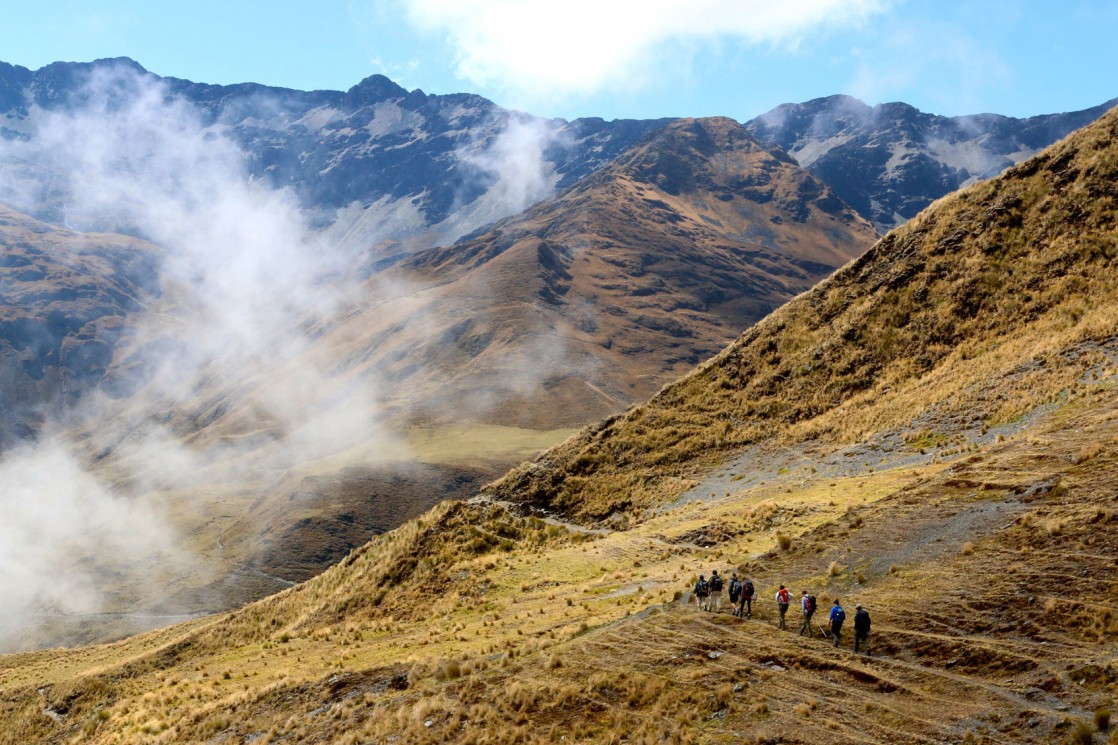College Study Abroad South America, Sample Itinerary
This is a sample itinerary. No two Dragons programs are the same. Every itinerary considers the unique strengths of the instructor team and interests of the student group.
| Week 1 | (PERU) After arriving in Cusco, we travel to our orientation site in the Sacred Valley of the Incas. In this inspiring location, we take in our beautiful surroundings, and get to know each other as a group. We engage in workshops on group dynamics and intercultural communication, set goals and expectations for the semester and introduce the curriculum for our for-credit courses. We also begin to formulate plans for our Independent Study Projects (ISPs) and start our language study with some basic survival lessons. |
|---|---|
| Week 2 | (PERU) Upon completing orientation, we travel to Ocongate, where we set out for our first trek as group. We spend several days circumnavigating the sacred Mount Ausangate, traveling over high passes, and rejuvenating our trail-weary bodies in natural hot springs. Along the way, we continue our introduction to language study. |
| Weeks 3-7 | (PERU) After our trek, we travel back to the Sacred Valley to the town of Urubamba which sits near the Urubamba river and the mountain of Chicon. Here in Urubamba we meet our extended homestay families. Our weeks in this community are defined by intensive language study and diving into our intercultural communication course. As with all academic courses, these are taught in intensive blocks and the language and intercultural communication course take place over the course of five weeks. As we dig into the academics of the program, we also make time to settle into a routine with our families during our five-week homestay. |
| We also have the opportunity to organize group explorations outside of Urubamba on some evenings and weekends, including a possible visit to Machu Picchu and/or other Incan sites in the area. Along the way, we discuss topics such as the impact of ecotourism, the rise and fall of the Incan Empire, and Andean cosmovision. Other possible travels that the group may embark on around the region might include a short-homestay in Parque de la Papa or day-hikes around the region. These experiences outside of our homestay community are also directly tied into the academic courses and provide additional opportunities to practice language and explore intercultural communication theories and best-practices. | |
| Weeks 8-11 | (BOLIVIA) Bidding farewell to Peru, we travel overland from Cusco to the Bolivian border on Lake Titicaca. From there, we go by boat to Isla del Sol (the Island of the Sun), the site of ancient ruins and the setting for both Quechua and Aymara origin myths. Here we spend time reflecting on our time in Peru, preparing for our transition into Bolivia, and switching our academic focus to our Regional Seminar and Independent Study Project courses. From Isla del Sol, we travel to La Paz, Bolivia’s bustling legislative and executive capital. We spend a couple of days exploring the city, meeting with government and non-governmental agencies and perhaps visiting the U.S. Embassy. |
| After our brief stay in La Paz, we travel to Sucre and Potosi. In Sucre, we engage in a number of activities and are exposed to the rich Quechua cultural foundation in the region. In addition, we travel to Potosí, one of the most historically significant cities in Bolivia. We visit an active mine, learning about the history of natural resource extraction in the region, social and political mobilization, and contemporary mining realities. We then travel overland to the heart of Bolivia: Cochabamba. Regarded as the “City of Eternal Spring”, the climate in this fertile valley is pleasant year-round. We make our way to the semi-rural community of Tiquipaya, about 30 minutes from the city center, where we engage with a short second homestay. | |
| Throughout these first several weeks in Bolivia – whether while travelling or in our second homestay - we focus on our Regional Seminar coursework and also begin instruction and planning for our ISPs. The Regional Seminar typically takes place over three weeks and the ISP course has three weeks of instruction and three weeks of intensive experiential work. | |
| Weeks 12-14 | (BOLIVIA) This is the phase of the program where all of the skills we have been developing are put to the test. During this two-week independent expedition period to an individually selected location in Bolivia, we work with our instructors to propose a plan to go deeper with our ISP topic. The goals of this phase are two-fold – to give students adequate time to fully immerse themselves in their ISP topic and to challenge themselves to do so in a truly independent manner. After the two-week period of independent study, we come back together to write our ISP paper and present our experiences to our peers. |
| Week 15 | (BOLIVIA) Closing out our time together, we spend our final days at a retreat center in Samaipata. This town is located in Bolivia’s eastern lowlands and borders the Amazon. Here we reflect on our journey, celebrate our time together, and prepare for the transition back home. We then return to La Paz and have one final day to tie up loose ends, enjoy each other’s company and stock up on beautiful Bolivian handicrafts from local artisans, and close out the semester. Before dawn breaks on the last day, we climb out of the city of La Paz and onto the vast altiplano once more, on our way to the airport. Filled to the brim with experiences and new knowledge and questions, we catch one last glimpse of the Cordillera Real as the sun rises on the last phase of our program: bringing it all home. |

